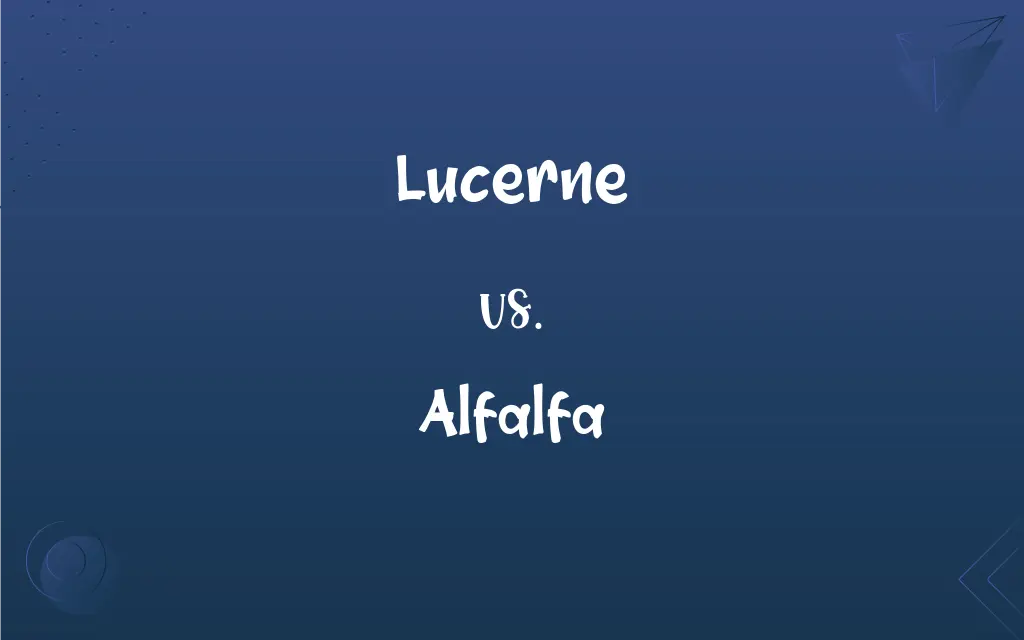Lucerne vs. Alfalfa: What's the Difference?
By Janet White & Harlon Moss || Updated on May 20, 2024
Lucerne and alfalfa are the same plant, known scientifically as Medicago sativa, but lucerne is the term used in British English, while alfalfa is used in American English.

Key Differences
Lucerne, commonly known in British English, refers to a perennial flowering plant known for its high nutritional value and use as animal fodder. Alfalfa, the term used in American English, describes the same plant, Medicago sativa, renowned for its deep root system that aids in soil health and drought resistance.
Lucerne is extensively cultivated in Europe and is valued for its rich protein content, making it an excellent feed for livestock. Alfalfa is widely grown in the United States and is similarly prized for its nutritional benefits and ability to fix nitrogen in the soil, improving agricultural sustainability.
Both lucerne and alfalfa serve similar purposes in agriculture, such as providing high-quality hay, silage, and pasture for grazing animals. Despite the different regional names, they share the same botanical characteristics, including deep taproots and the ability to enhance soil fertility through nitrogen fixation.
In terms of growth and management, lucerne and alfalfa require similar conditions, thriving in well-drained soils and full sunlight. They are both resilient plants that can endure periods of drought due to their extensive root systems, making them valuable crops in various climates.
Lucerne and alfalfa are also utilized in the production of sprouts for human consumption, offering a rich source of vitamins and minerals. Their roles in crop rotation and soil health management underscore their importance in sustainable agriculture practices.
ADVERTISEMENT
Comparison Chart
Terminology
British English
American English
Use
Animal fodder, soil improvement
Animal fodder, soil improvement
Nutritional Value
High in protein
High in protein
Cultivation Region
Predominantly Europe
Predominantly United States
Soil Benefits
Nitrogen fixation, deep roots for drought resistance
Nitrogen fixation, deep roots for drought resistance
ADVERTISEMENT
Lucerne and Alfalfa Definitions
Lucerne
A perennial plant used as animal feed, rich in protein.
Farmers in the UK plant lucerne to improve soil health.
Alfalfa
The American English term for lucerne, used as animal feed.
Alfalfa is a key crop for dairy farmers in the USA.
Lucerne
Commonly grown in Europe for hay and silage.
Lucerne is a staple crop for European livestock farmers.
Alfalfa
Known for its extensive root system, providing drought resilience.
Alfalfa can survive dry conditions due to its deep roots.
Lucerne
Utilized in crop rotation to enhance nitrogen levels in the soil.
Lucerne fields help in maintaining soil fertility.
Alfalfa
Consumed as nutritious sprouts by humans.
Alfalfa sprouts are added to sandwiches for extra nutrients.
Lucerne
Used for human consumption as sprouts rich in vitamins.
Lucerne sprouts are popular in salads for their nutritional benefits.
Alfalfa
Enhances soil fertility through nitrogen fixation.
Alfalfa is often included in crop rotation to improve soil health.
Lucerne
Known for its deep root system, aiding drought resistance.
Lucerne thrives in well-drained soil with full sunlight.
Alfalfa
Widely grown in the United States for hay production.
Alfalfa hay is preferred for its high protein content.
Lucerne
Alfalfa.
Alfalfa
A southwest Asian perennial herb (Medicago sativa) in the pea family, having compound leaves with three leaflets and clusters of usually blue-violet flowers. It is widely cultivated as a pasture and hay crop.
Lucerne
(British) Alfalfa.
Alfalfa
(uncountable) A plant, principally of Medicago sativa, grown as a pasture crop.
Lucerne
See Lucern, the plant.
Alfalfa
(countable) A type or breed of this plant.
Lucerne
Important European leguminous forage plant with trifoliate leaves and blue-violet flowers grown widely as a pasture and hay crop
Alfalfa
The lucern (Medicago sativa), a leguminous plant having bluish purple cloverlike flowers, and cultivated for fodder; - so called in California, Texas, etc.
Alfalfa
Important European leguminous forage plant with trifoliate leaves and blue-violet flowers grown widely as a pasture and hay crop
Alfalfa
Leguminous plant grown for hay or forage
FAQs
Where is lucerne predominantly grown?
Lucerne is mainly grown in Europe.
Do lucerne and alfalfa have the same nutritional benefits?
Yes, both are high in protein and other nutrients.
What is the main difference between lucerne and alfalfa?
They are the same plant; lucerne is the British term, and alfalfa is the American term.
Why are lucerne and alfalfa important for soil health?
They fix nitrogen in the soil and have deep root systems that help with drought resistance.
Can lucerne and alfalfa be used interchangeably in agriculture?
Yes, they are the same plant and serve identical agricultural purposes.
How does lucerne/alfalfa contribute to sustainable farming?
They improve soil fertility through nitrogen fixation and are used in crop rotations.
Are lucerne and alfalfa used for the same purposes?
Yes, both are used for animal fodder, soil improvement, and human consumption as sprouts.
What regions primarily cultivate alfalfa?
Alfalfa is predominantly grown in the United States.
What is a notable characteristic of lucerne/alfalfa's root system?
They have deep taproots that provide excellent drought resistance.
What is a common use of lucerne/alfalfa in animal farming?
They are widely used as high-protein feed for livestock.
Do lucerne and alfalfa require special care during cultivation?
They need well-drained soil and adequate sunlight, with regular monitoring for pests and diseases.
Can lucerne/alfalfa grow in poor soil conditions?
They prefer well-drained, fertile soils but can improve poor soils over time through nitrogen fixation.
What is a key advantage of growing lucerne/alfalfa?
They provide high-quality forage for animals and improve soil health.
What are the benefits of including lucerne/alfalfa in crop rotation?
They improve soil structure, fertility, and help control pests.
How often should lucerne/alfalfa be irrigated?
They require regular irrigation, especially during dry periods, but are drought-resistant.
How long can lucerne/alfalfa crops last?
They are perennials and can last several years with proper care and management.
Are lucerne and alfalfa suitable for all climates?
They thrive best in well-drained soils and full sunlight, suitable for various climates with proper management.
Is there a difference in the harvesting methods for lucerne and alfalfa?
No, the harvesting methods are the same since they are the same plant.
Are there any pests specific to lucerne/alfalfa?
Yes, common pests include aphids and weevils which can affect their growth.
Can humans eat lucerne/alfalfa?
Yes, lucerne/alfalfa sprouts are nutritious and commonly consumed.
About Author
Written by
Janet WhiteJanet White has been an esteemed writer and blogger for Difference Wiki. Holding a Master's degree in Science and Medical Journalism from the prestigious Boston University, she has consistently demonstrated her expertise and passion for her field. When she's not immersed in her work, Janet relishes her time exercising, delving into a good book, and cherishing moments with friends and family.
Co-written by
Harlon MossHarlon is a seasoned quality moderator and accomplished content writer for Difference Wiki. An alumnus of the prestigious University of California, he earned his degree in Computer Science. Leveraging his academic background, Harlon brings a meticulous and informed perspective to his work, ensuring content accuracy and excellence.































































